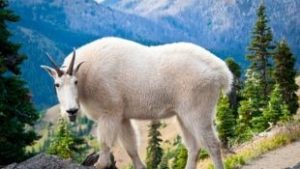It’s Mountain Goat Time
You have heard, no doubt, about the plans for the mountain goats in the Olympic National Park and on the Olympic Peninsula of Washington State. Mountain goats are, arguably, our most unique large mammal. I’m always surprised when people who love our back country know so little about them.
This time of year, as more and more hikers get deeper into the high country of the Cascade Mountains, I always get a handful of questions about mountain goats, or “some big white animal.”
“So we climbed that ridge between French Cabin Creek and Lake Kachess on Sunday,” Young Homey said in passing, “and we saw these three big shaggy white animals way up in the rocks. There was a little one, too. One of the guys said they were very rare white bears, but it was obvious after we watched them that they were probably mountain goats. Do they belong there, or were they brought into Washington? And are they going to be removed like the ones in that Olympic National Park, where that guy was killed? Are there a lot of ‘em?”
Given my role as chair of the Wildlife Education Committee of the Reecer Creek Rod, Gun, Working Dog & Outdoor Think Tank Benevolent Association, and governed by our bylaws, I am sworn to answer all inquiries. Herewith, my response to Homey – and then some.
Mountain goat’s scientific name is Oreamnos americanus. Not a true goat, it is most closely related to the chamois of the European Alps and some African antelope. It acts like a goat on rocky outcroppings, cliffs and alpine tundra in some of the most remote high country of North America, so the name sticks.
A large billy may be three feet at the shoulder, five feet long, and weigh three hundred pounds. A nanny may reach a bit over half that weight. Their shaggy white hair and shoulder hump may be why they were often called “white buffalo” by Native Americans and early European settlers. Shed hair may be found all over goat habitat all summer long, and is often woven into warm blankets and garments by collectors.
Mountain goats, it is said, live one step below the sky. There, they feed on low grasses, sedges, mosses and willow shoots. Their black hooves have concave rubbery pads surrounded with sharp, hard edges, enabling them to keep solid footing even on near-vertical cliffs. An amazing sense of balance, powerful hind legs, and forequarters strong enough to lift them to a higher ledge make their climbing legendary.
Mating takes place in November and December, and one or two six-pound kids will arrive in May or June. An eagle may occasionally take a kid, but few other predators bother them. They rarely move lower in winter, and icy snows and hundred-mile-an-hour winds threaten their survival. Even the best of feet may fail on ice, and freeze-thaw action will loosen benches and ledges. Many goats have scars or broken horns, proving survival ability, and it is not uncommon for several animals to perish in the misjudged crossing of an avalanche chute.
The mountain goat is native to the Cascade Mountains of Washington, but not native to the Olympic Mountains, where it was transplanted in the 1920s. Unfortunately, the Olympics lack a key set of nutrients goats need, and their constant search for it among humans has led to their long-held “pest” status. In the 1980s, their numbers surpassed 1,000. While hundreds of them were moved out of the national park, numbers stayed high, and biologists think there may now be as many as 725 goats in the national park and the adjacent national forest (somewhere around 3,000 goats live in Washington State). A new plan for the Olympic goats was released in May.
Because goats crave salt – not naturally occurring on the peninsula – they seek it and other minerals along trails and in wilderness campsites where they find them in people’s urine, packs, sweaty clothing, and places where cooking water has been dumped. The goats’ need for access to trails and campsites has led to a lack of fear of humans – that pest status – and was likely a factor in the 2010 death of a park visitor gored by a large billy.
Under the plan released in May – a coordinated effort of the National Park Service, US Forest Service, and the Washington Department of Fish and Wildlife – all Olympic Peninsula goats will get one-way tickets to the North Cascade Mountains, to supplement native populations there. Using helicopters, during two-week summer periods, the mountain goats will be moved over the next three to five years. Any goats remaining after all capture efforts will be shot and killed.
Until the removal is completed, you may still find goats in the Olympics; check out the cliffs on Mount Ellinor, out of Hoodsport. Our Washington State Cascade Range goats are wild and watchable. Head up to the Sunrise Visitor center in Mount Rainier National Park and look around. Closer to our Central Washington home, drive up to the Timberwolf Mountain fire lookout, off the Bethel Ridge Road from Highway 12, and look around. You’ll see them along Lake Chelan, as you boat up to Stehekin. Kachess Ridge works, and I always see goats on the cliffs of Mount Si, out of North Bend. If you’re looking for a mini-vacation, head for Flume Creek Mountain Goat Viewing Area out of Metaline, northeast of Kettle Falls, where you may also see moose, bighorns and (maybe) woodland caribou.
For a great read, get Chadwick’s A Beast the Color of Winter. For your trip, pick up a copy of the Washington Wildlife Viewing Guide at a local bookstore or online.
Grab your binoculars and spotting scope and go. It’s High Country goat watching time.








